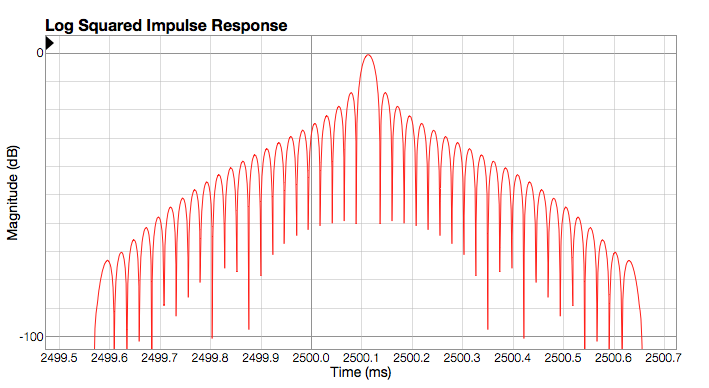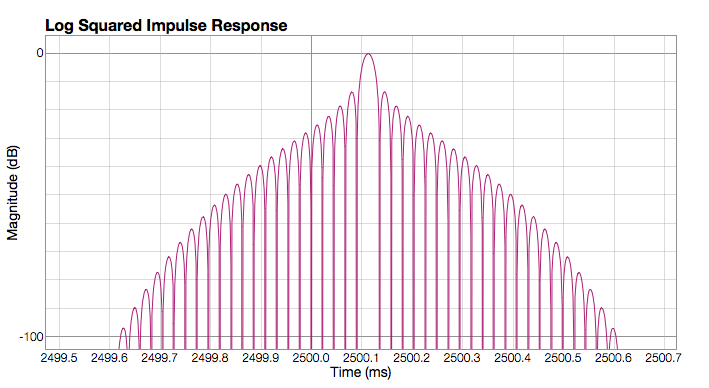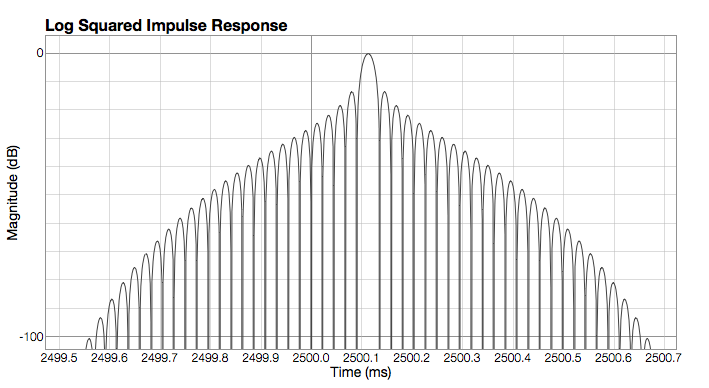Anyone if tell the different btw NOS and original sac filter???
Thank so much
They are completely different things. The original filter is has medium degree of roll off but was considered too forward by some or even many people.
The NOS filter does not actually filter at all - all the coefficients are set to 1 so the audio is passed unaltered and is only up sampled. The side effect is none of the mirror images of the original signal that appear in the up sampled signal are removed. Sampling theory demands these mirror images are removed so NOS is considered a bit controversial but the results can sound very, very good.
The only NOS version to use is the 1021filtNewNOS as it is correctly configured for all settings and has pos' de-emphasis filters. None of the other versions of the NOS filter are completely correct.
Nevertheless,
@Soren, a petition:
It should not cost to much FPGA resources to implement the coefficients as "partial floats", and avoid any headache about their precision.
You could store the coefficients as mantissa and shift in LSB direction. That would only add a shift of the bits after every multiplication of the convolution in the accumulator.
I see the idea. But you can not just add a shifter between the multiplier and accumulator, as the multiplier and accumulator are part of the FPGA's DSP blocks. You would have to redo the architecture and add more pipeline stages, of course not impossible....
A simpler way is to keep 32 bit coefficients but change format to a custom float format, where the uC (or fpga for speed) convert to full 35 bit FPGA DSP block format when loading them. Or go to full 35 bit format, there are plenty of space in the flash for storage.
It was just so convenient to stay at 32 bit fix format when starting....
Filter Tuning 2
I thought I try to articulate what I think is going on with the time smear effect, and why the LSIR plots are useful in understanding the filters.
The basic premise is that the wider the "smear" the greater the apparent energy in the signal. As far as I can tell the peak value of the signal is not effected so the signal level measures the same. This is why the effect does not show up in frequency response plots.
The Log Squared Impulse Response shows how the impulse effects the signal plotted as amplitude vs time. As the "shoulders" of the impulse become wider and higher the apparent level of lower amplitudes is increased. It's this increase that results in what gets described as "detail". The race off seems to be that as the this boost increases the dynamic quality is reduced as there is less apparent range between soft and loud sounds. Anyway that is my interpretation and it seems to work in general terms 😉
Thought it might illuminate things if we had a look at a few filters in the LSIR view.
Soekris Stock 441/FIR2

The Stock 441 filter has quite broad high level "shoulders" to the main impulse. This will tend to boost lower level detail. I believe the fact that the spread is more pronounced in the -20 to -30dB range accounts for the "forward" and "shouty" character of the filter.
NewNOS

NOS filter concentrates all the energy into a single impulse.
NQv4RG

v4RG was considered to be rolled off in the high end and female vocals behind a "curtain".
NQtb65

Vastly improved high end response and no obvious curtain effect on female vocals. The main change to the filter is that the width of the transition band was decreased to 6.5kHz making the filter slightly steeper.
NQtb75

This "splits the difference" between the previous two, with transition band at 7.5k. Not really veiled but sounds pretty smooth to my ears.
Anyway there are clear trends in terms the structure of the impulse plotted this way and the perceived sound, so it appears to give us a way to visualising where issues lie and a means to address/correct characteristics.
I thought I try to articulate what I think is going on with the time smear effect, and why the LSIR plots are useful in understanding the filters.
The basic premise is that the wider the "smear" the greater the apparent energy in the signal. As far as I can tell the peak value of the signal is not effected so the signal level measures the same. This is why the effect does not show up in frequency response plots.
The Log Squared Impulse Response shows how the impulse effects the signal plotted as amplitude vs time. As the "shoulders" of the impulse become wider and higher the apparent level of lower amplitudes is increased. It's this increase that results in what gets described as "detail". The race off seems to be that as the this boost increases the dynamic quality is reduced as there is less apparent range between soft and loud sounds. Anyway that is my interpretation and it seems to work in general terms 😉
Thought it might illuminate things if we had a look at a few filters in the LSIR view.
Soekris Stock 441/FIR2
The Stock 441 filter has quite broad high level "shoulders" to the main impulse. This will tend to boost lower level detail. I believe the fact that the spread is more pronounced in the -20 to -30dB range accounts for the "forward" and "shouty" character of the filter.
NewNOS
NOS filter concentrates all the energy into a single impulse.
NQv4RG
v4RG was considered to be rolled off in the high end and female vocals behind a "curtain".
NQtb65
Vastly improved high end response and no obvious curtain effect on female vocals. The main change to the filter is that the width of the transition band was decreased to 6.5kHz making the filter slightly steeper.
NQtb75
This "splits the difference" between the previous two, with transition band at 7.5k. Not really veiled but sounds pretty smooth to my ears.
Anyway there are clear trends in terms the structure of the impulse plotted this way and the perceived sound, so it appears to give us a way to visualising where issues lie and a means to address/correct characteristics.
Attachments
Last edited:
Paul, this is really interesting and makes me even more interested listening to a NOS filter. Unfortunately my Truepath (Class-T tripath 3020 amplifier) distorts highly if I apply to the dam any NOS filters! So I've still have not heard it. I plan this week to compare the different versions of IP and Nyquist filters you have uploaded. Thank you again for your work.
Paul, this is really interesting and makes me even more interested listening to a NOS filter. Unfortunately my Truepath (Class-T tripath 3020 amplifier) distorts highly if I apply to the dam any NOS filters! So I've still have not heard it. I plan this week to compare the different versions of IP and Nyquist filters you have uploaded. Thank you again for your work.
Not that surprising. The HF images generated by the NOS are likely to be interfering with switching frequency of the TA3020.
Unless you are really curious to follow the evolution of the Nyquist filters I'd stick to the last few versions - NQtb65 and NQtb75. I'd only load an earlier revision if you wanted to hear what a "curtain" over female voices sounded like.
Just trying to chase a decent balance between detail and overall balance with the NQ filters.
75 is perhaps slightly too recessed, 65 a little too forward...
Not sure if NQtb70 is the answer but might help narrow the choices down...
On of the things I'm listening for is how the filter places vocals in the mix and NQtb70 is pretty good in this regard on my setup.
75 is perhaps slightly too recessed, 65 a little too forward...
Not sure if NQtb70 is the answer but might help narrow the choices down...
On of the things I'm listening for is how the filter places vocals in the mix and NQtb70 is pretty good in this regard on my setup.
Attachments
Whats the command to show what filter file is currently loaded in the DAM using the serial i/f?
//
//
Whats the command to show what filter file is currently loaded in the DAM using the serial i/f?
//
I don't think that feature is implemented yet.
So comparing 1021filtNQtb70.skr with 1021filtN3.skr b70 is a bit more polished for me. Little darker overall with a slight emphasis on the edges of the spectrum. Playing Shostakovich: Symphony No. 8 Vasily Petrenko (Naxos), the N3 gives me a more furious and wild presentation, but still with an inner core of control, experience where b70 feels a bit held back and controlled. N3 has maybe a soundstage that tilts a bit upwards compared to b70.
I'm having a great time with N3. I'm playing:
DAM on SMPS to a pair of JG buffers (SMPS fed) without the filters function (these are a really good addition -DAM seem to need these) into Hypex 2* NC400/SMPS600. Side wall mounted speakers. All cables singel wire/single core. It shall be noted that no part of this system is housed in a metallic hosing/boxes in order to avoid sucking the life out of the music intensity.
Dynamics are superb, almost frightening. I think Eldam would poop his little "pantalong" if he could hear it 🙂
//
I'm having a great time with N3. I'm playing:
DAM on SMPS to a pair of JG buffers (SMPS fed) without the filters function (these are a really good addition -DAM seem to need these) into Hypex 2* NC400/SMPS600. Side wall mounted speakers. All cables singel wire/single core. It shall be noted that no part of this system is housed in a metallic hosing/boxes in order to avoid sucking the life out of the music intensity.
Dynamics are superb, almost frightening. I think Eldam would poop his little "pantalong" if he could hear it 🙂
//
Last edited:
...
DAM on SMPS to a pair of JG buffers (SMPS fed) without the filters function (these are a really good addition -DAM seem to need these)
....
//
Same here! JG buffer without filter ... Gives that extra kick in dynamic and soundstage... Just what the DAM needs. Next week I'll be receiving a Tortuga passive board. Let's see if it improves compared to an already good DAM volume control.
Same here! JG buffer without filter ... Gives that extra kick in dynamic and soundstage... Just what the DAM needs. Next week I'll be receiving a Tortuga passive board. Let's see if it improves compared to an already good DAM volume control.
Aha 🙂
I put 38,8k as input impedance.
//
It's not important but can be useful to normalize the filters to 1 in txt file.Lowest value* that registers as 1 is: 1.16415321826934808E-10
rather than the theoretical value of: 1.16415321826934814453125E-10
With scaling factor of 1
The lowest value* I found that would convert to 1 in the .skr file was 9.31322574615478464E-10
rather than 9.31322574615478515625000000000E-10
Probably you increases precision if MKROM.exe not need to multiply coefficients by 8, 4, 2.
And you get more precision decreasing the minimum value coefficient you can obtain.
Sorry guys - doing mods on the basis of stock DAM.
I'm disregarding listening impressions for modified setups so don't bother posting up for me. I won't be making changes based on them.
I'm disregarding listening impressions for modified setups so don't bother posting up for me. I won't be making changes based on them.
Aha 🙂
I put 38,8k as input impedance.
//
47k... I wonder if I should not use the buffer with filter and remove the DAM output filter... Any thoughts? Oops this is off topic... I though we were on the other thread...
Then to stay on topic, I just came from a long holiday and this morning I swapped crapMagic for NQtb70. This new one is really beautiful to my ears, still has to compare it with the NOS which was my favorite.
I also think that rePhase doesn't offer precise enough control of specific parameters to be the ideal solution for DAC reconstruction filters. It will be perfect for doing crossover filters.
Hi Paul,
What parameters are you thinking of?
I'd love to improve rephase based on your experience with designing DAC filters here.
Ser it as a mod of my power amps 🙂
When your reports are completely at at odds with my observations and those of at least two other people with stock DAMs you shouldn't be too surprised that you start to look like an "outlier"...
I'm interested in your observations but I can't really do anything useful with reports from owners of DAMs with that have been modified with tube buffers, transformers, etc, etc,
Last edited:
Hi Paul,
What parameters are you thinking of?
I'd love to improve rephase based on your experience with designing DAC filters here.
I'm not certain how critical it really is but what I've been doing is precisely the width of the transition band. I'm making changes in increments of 250Hz to the transition band width in an attempt to adjust tonal balance.
Filter Tuning 3
I was starting to doubt the veracity of my theory that the time smear works almost entirely in the mid to high end so looked at the spectrum of the impulse in Isotope RX. Sure enough the impulse spectrum looks very much like an inversion of the Log Square Impulse Response. For most filters there is little influence below 10kHz.
This shows 0-22kHz, 2.4495-2.5007 seconds and 0-85dB and done on SoX processed impulse using bother FIR1 and FIR2 filters.
I'm half-tempted to call these "Elephant diagrams" 😉
Default Soekris 441

Time smear starts to bite at a lower frequency than the other filters tested. This might be due to the lower corner frequency of the filter, and may be a reason for the "forward" character some listeners have reported.
TotalCrap:

Someone observed in the construction thread that the totalcrap was "very detailed". I believe this is mainly due to the large amount of time smear above 12.5kHz increasing the amount of energy in the HF.
IPv4p35:

You can clearly see the redistribution of energy resulting from the intermediate phase. And again there is little time smearing below 10kHz.
NQv4:

NQv4 was perceived to be rolled off in the HF. I think this has about the same total smear as the IPv4p35 filter but with symmetrical distribution. The main thing I can pick is that the smear extends to a much lower frequency in the post-ringing of the IPv4 which will give better perceived HF response. The NQv4 shifts the cut in of the smearing to a higher frequency (corner freq is higher), and there is less smearing.
cheers
Paul
I was starting to doubt the veracity of my theory that the time smear works almost entirely in the mid to high end so looked at the spectrum of the impulse in Isotope RX. Sure enough the impulse spectrum looks very much like an inversion of the Log Square Impulse Response. For most filters there is little influence below 10kHz.
This shows 0-22kHz, 2.4495-2.5007 seconds and 0-85dB and done on SoX processed impulse using bother FIR1 and FIR2 filters.
I'm half-tempted to call these "Elephant diagrams" 😉
Default Soekris 441
Time smear starts to bite at a lower frequency than the other filters tested. This might be due to the lower corner frequency of the filter, and may be a reason for the "forward" character some listeners have reported.
TotalCrap:
Someone observed in the construction thread that the totalcrap was "very detailed". I believe this is mainly due to the large amount of time smear above 12.5kHz increasing the amount of energy in the HF.
IPv4p35:
You can clearly see the redistribution of energy resulting from the intermediate phase. And again there is little time smearing below 10kHz.
NQv4:
NQv4 was perceived to be rolled off in the HF. I think this has about the same total smear as the IPv4p35 filter but with symmetrical distribution. The main thing I can pick is that the smear extends to a much lower frequency in the post-ringing of the IPv4 which will give better perceived HF response. The NQv4 shifts the cut in of the smearing to a higher frequency (corner freq is higher), and there is less smearing.
cheers
Paul
Attachments
Last edited:
- Home
- Source & Line
- Digital Line Level
- Filter brewing for the Soekris R2R








